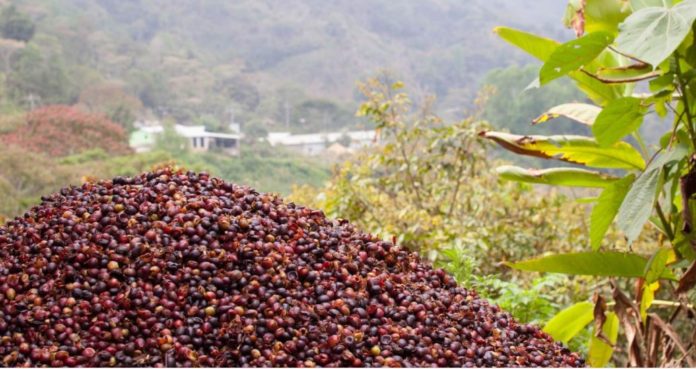Experts are predicting a dramatic drop in the availability of coffee as temperatures rise in Africa, leaving farmers facing an uncertain future, and placing the US$2.5 billion market under threat.
According to Africa Business, coffee growing is steady right now, but it believes that the days of producing the world’s most popular bean are numbered.
On Mount Elgon, an extinct volcano on the Ugandan-Kenyan border, Kenneth Barigye grows Arabica beans.
He also farms the crop in the Rwenzori Mountains and in Kisoro in Uganda, a country that registered its highest coffee exports in three decades last year.
“We are experiencing yield shocks resulting from adverse weather and the burdens of pests and disease which have a substantial impact on the incomes of smallholder farmers,” Barigye, managing director of Mountain Harvest, said.
“Further compounding these challenges is the lack of access to finance to purchase critical inputs leading to poor soil nutrition and low quality and productivity of coffee.”
Arabica is sold in most coffee shops, including large global chains like Starbucks, Costa, and Seattle Coffee Company. The bean needs high altitudes and cold temperatures to grow, unlike the less popular Robusta.
Robusta can be grown in lower elevations in much higher temperatures.
In recent years, global coffee consumption has been soaring, yet despite the high demand, climate models predict there will be a dramatic drop in the availability of the crop as temperatures rise.
According to data from Statista, most coffee-producing countries are in Africa, and Ethiopia is the leading exporter, getting over US$1.2 billion worth of exports per year while Uganda is the second largest with around US$594.2 million.
A study carried out early this year shows that climate change will dramatically decrease coffee production in most African countries by 2050, and West Africa is expected to be the worst-hit region.
Compared with cashew and avocado, coffee was found to be the most vulnerable crop to climate change.
“Coffee is very sensitive to even small increases in temperatures and the impact can vary depending on the stage the crop is in. A little warming at the wrong time can affect yield, aroma, and flavour,” Michael Hoffman, director at the Cornell Institute for Climate Smart Solutions, said.
Flooding and droughts, predicted to become more frequent under climate change, can also stunt growth as too much rain can cause mould and interfere with harvesting and in droughts the coffee fruit does not grow as expected.
Hoffman added that the increasing global temperatures would spell disaster for African coffee farmers.
“The challenges faced by coffee farmers in Africa will only get worse as climate change impacts intensify. Some scientists predict that the suitable area for growing coffee in Africa could be reduced by 50% by mid-century.”
Bariyige also added: “Beyond growing, the current climate change trajectory has an additional effect on our business. As a specialty coffee exporter, I need the right conditions to produce coffee cupping above 84 points.
“These conditions include slow growth of the cherry to maximise absorption of sugars and slow drying. As we get more hot weather, we will see fast growth which will affect both the absorption of sugars and the size of the cherry. Hot weather will also mean faster drying which has a negative effect on the quality of the cup.”
Daniel Habamungu Chinyabuguma, the managing director of Muungano Agricultural Cooperative in the Democratic Republic of Congo, said coffee farmers in that country are seeing more erratic weather patterns, reaping havoc for the coffee growing -sub-sector.
“When it rains a lot there are erosions which in turn will carry away the various fields and the hail will also damage the drupes and we lose the yield,” he said.
“When there’s overwhelming sun, it will create major evapotranspiration and the nutrient reserves will be empty and the coffee trees will flower but they will be unable to feed even the drupes so yields are automatically impacted.”
However, experts urged coffee growers to take action to mitigate the effects of climate change.
“I see the solution in promoting agroforestry and increasing the number of coffee trees in an acre,” Barigye said.
“Such a farming system is capable of restoring the forest cover while increasing Arabica productivity by at least 69%. The increased productivity will increase the farmer’s capacity to invest in irrigation systems.
“The second solution is to prepare for the worst-case scenario where farmers cannot grow coffee. Such a scenario requires diversification of sources of income to include income generating species that are heat tolerant such as avocado which luckily enough can be intercropped with coffee as part of the agroforestry solution.”
Hoffman also agreed, adding that farmers could use shade crops, like avocado, bananas, guava or mango, to help keep the coffee plants cooler and to provide the farmers with other income, some of which they can use to fund climate adaptation measures.
“In some areas of the world shade trees increase bird populations, which feed on insect pests of coffee. Another option is to move coffee plantings to higher elevations, assuming this is feasible and does not interfere with upslope forest conservation efforts,” Hoffman said.
“To help farmers adapt to the changing conditions, they need to know what to do and coffee cooperatives can foster training programmes for coffee growers. Through services offered by cooperatives, grower profits can increase, allowing them to invest more in climate-smart practices.”
The experts also agreed that the best mitigation was prevention as healthy plants are more resistant to pests and drought, and have higher yields.
“Nutrient-rich, biodiverse soils grow healthy plants. Regular post-harvest pruning and shade management regulate on-farm temperatures, prevent soil erosion, and allow plans to direct nutrients to new growth, increasing productivity.”









